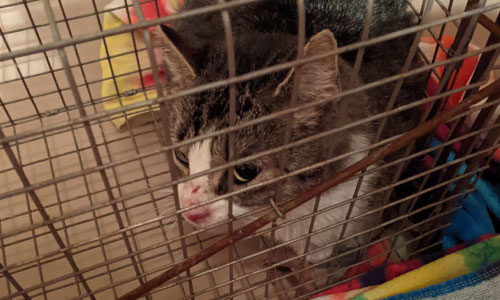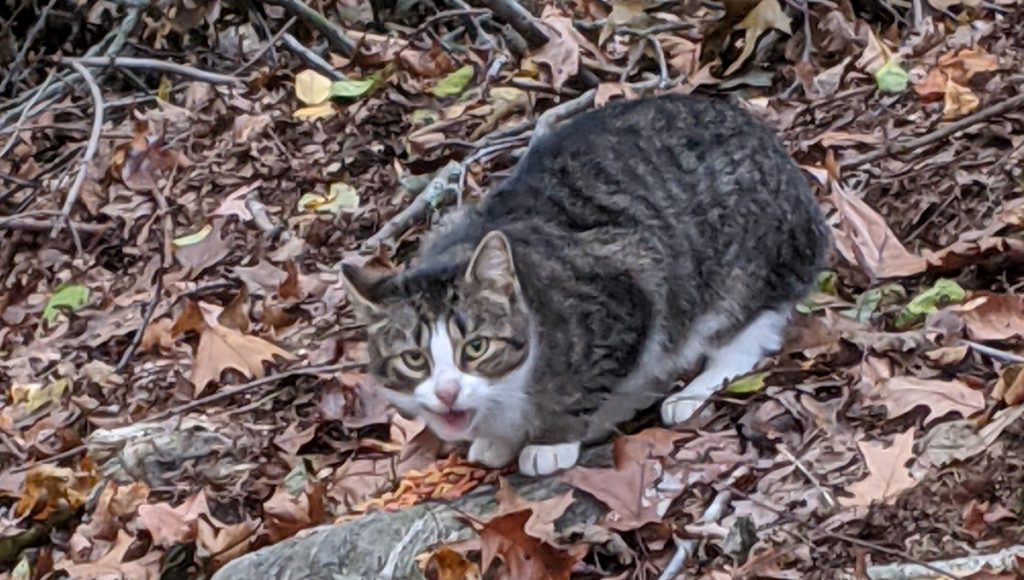TEAMWORKS

Finally calm in the trap the night before surgery – wish I could let her know she would be OK!
I have been the Program Coordinator for TEAM since 2013. In April 2020, after my husband and I moved to Norwich, I quickly realized that what I have always heard from our clients in that area is true — there are more than a few free-roaming stray and feral cats in the city!
One in particular, whom I named Alice, would show up by our home frequently, so I bought some dry cat food and began to feed her. To let her know she could rely on a daily meal, I fed her in the same spot and called to her every time.
Soon, I started to gain her trust, and we established a pattern. Sometimes I saw her daily, and other times she disappeared for two to three weeks, leading me to suspect the worst had ended the challenging life of a feral cat: was it a car, a predator, an illness, or the elements? But just as I assumed she was gone, she would appear again for dinner!

Since Alice was an adult who was accustomed to living outdoors, I knew the chances of making her a house cat were slim, but I wanted to do what I could to improve her health and well-being and, just as importantly, prevent her from bringing more kittens into the world. So, I made plans to put into practice what I have encouraged our clients to do for many years: TNR (Trap, Neuter, Release).
By early November, as temperatures dropped, it was time to take action. Trapping is difficult in all weather but tougher during winter weather months. So, I made an appointment for Alice to be spayed and borrowed a trap from TEAM.
Luckily, on one unseasonably warm day, I called for her after work, and she emerged from the woods! I grabbed a can of wet food and set the trap in the place where she ate. I camouflaged the trap with leaves and sticks and put the food at the far end of it, so she would have to go all the way in to eat and “spring” it. Then, I went into my house to wait. But I didn’t have to wait long. In just a few moments, I caught her. We were both shocked!
When she saw me approach, poor Alice tried to bolt out of the trap; this caused some bruising to her nose when she hit the other side, hoping to get away from me. This made me feel awful, but overall, I was glad she was trapped. Once her initial shock wore off, she hissed and swatted at me when I came near. I tried to reassure Alice (and myself) that this was all for the best, picked up the trap, and headed inside.
Because most people trap cats the night before surgery, TEAM instructs them to leave the cat in the trap and put it in a safe, quiet place away from household activity. A bathtub makes a great holding area, so I put Alice in ours. Careful not to let her out, I was able to slide a small paper plate inside the trap and add a little water to the plate. I covered the trap with a towel to keep her warm and limit how much she could see, to try to keep her a little calmer overnight.
The next morning, we went to our appointment. Although Alice was in the trap, I brought a hard-plastic carrier along for her to recuperate and to travel home in after surgery. While onboard the clinic, in addition to being spayed and vaccinated, Alice’s left ear got a small TIP, which is a universal way to identify her as a free-roaming cat that has been sterilized so that she does not have to be trapped again.
The night following surgery was stressful for both of us! As Alice recovered and became more alert, she began to panic, looking for a way out. Although she had nibbled the tablespoon of food and water that I offered her, it was clear that she was upset and nervous about being confined.
TEAM advises clients to keep feral cats indoors for at least 24 hours after surgery. I hoped Alice might want to stick around longer, but it was apparent that she did not want to be indoors, so I released her.
While at work, I speak to many people who have experienced the same thing as I did with Alice. As much as we want the cats to stay with us after being spayed or neutered, it is not always possible. Alice is truly a feral cat who prefers her life outdoors. I continue to put food in the same place where I trapped her, hoping she will continue to visit.
Do you feed a feral cat?
There are many cats similar to Alice around our state. Based on calls to the office, I am not the only one trying to help them. The good news is that any Connecticut resident willing to TNR can use the TEAM Incentive Program (TIP) just like I did.
Thanks to TIP, if are willing to bring a feral cat to the TEAM clinic for spay/neuter, and meet the following conditions, you may be eligible to have a portion of the fee refunded back to you.
- Transport cat to TEAM in a humane trap (TEAM has traps available to borrow);
- Agree to an ear “tip” at the time of surgery;
- Return/release the cat to an outdoor habitat where you will continue to feed it and, if possible, provide shelter (barn, garden shed, porch, basement, etc.).
If you would like to learn more about the TIP program so you can help a cat similar to Alice, call 1-888-FOR-TEAM and ask for Lacey. Now that I have experienced TNR for myself, I understand the process is not easy, but it is rewarding. I would be happy to assist you with information on trapping a cat in your community.


